Events have taken a turn in Britain as the first mass reaction took place this week against the programme of vicious cuts being introduced by the Tory-led coalition. On Wednesday, November 10th, London witnessed an overwhelming response from the students as a demonstration of over 50,000 marched in protest at the attacks taking place in Higher Education.
The
demonstration, a joint demo by the National Union of Students (NUS) and
the University and College Lecturers Union (UCU), marked a turning
point for the class struggle in Britain, which will be seen by workers
everywhere as the first expression of the anger and frustration
developing within society as a whole. Not since the protests against the
Iraq war have such numbers been seen in Britain, and even the famous
student protests against the Vietnam War in Grosvenor Square in 1968
were only slightly larger.
Fees and cuts
In 1998 the New Labour government scrapped free education and grants.
Despite an election promise not to, New Labour passed a law in 2004 to
increase the cost of tuition fees in Higher Education (HE – university
level education) from £1,250 to £3,290 per year. The law only narrowly
passed in the House of Commons, with Tony Blair having to rely on
support from the Tories in order to overcome a Labour backbench
rebellion.
In light of the capitalist crisis the Browne Review recommended on
October 12th this year that universities be allowed to charge unlimited
fees for tuition, going significantly further than what had been
expected. This reveals the depths of the crisis. Despite the new
Tory-Liberal coalition government promises to take on board the
recommendations of the Browne review, the government drew back from the
brink for fear of the social and political consequences. In the end they
announced plans to allow fees of up to £9,000 per year. Although
students will not be required to pay any of this money upfront, the debt
that they accumulate will be borrowed at interest – interest that will
go straight to the banks!
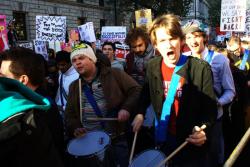 In addition to the increasing fees, the coalition government announced in the Comprehensive Spending Review (CSR) on October 20th
In addition to the increasing fees, the coalition government announced in the Comprehensive Spending Review (CSR) on October 20th
that the teaching budget to universities would be cut by 40%. This
raises the possibility of entire universities closing, along with course
closures at most universities. Students, therefore, will not be the
only ones affected by the cuts; the UCU estimates that over 22,000 jobs
in universities are at risk, including both lecturers and support staff.
The picture is just as bleak in FE (Further Education – education for
16 to 18 year olds), with planned cuts of 25%. FE institutions educate
and train more over-16 students than sixth forms and universities put
together. They are clearly needed: some one million 16 to 24-year-olds
are classified as "NEETS" – not in education, employment, or training.
The education maintenance allowance (EMA), of up to £30 per week for
poor families, is to be scrapped. Nationally 46% of FE students get the
EMA; in poorer areas the figure is nearer to 80%.
These cuts, which form part of a generalised attack on public
services, are tearing up the so-called consensus politics of the past
two decades. The illusion that in Britain there existed a type of
"meritocracy", no matter how imperfect, where your kids had the
opportunity to reach the top with a bit of hard work, has been
shattered. It is of no surprise, therefore, that bubbles of anger are
beginning to float to the surface.
National demonstration
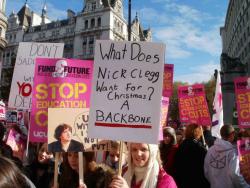 Until
Until
recently the movement against university cuts had been primarily led by
university staff, who were facing the more immediate repercussions of
the crisis, in the form of job losses, wage freezes, and attacks on
pensions and conditions. As a result, the UCU has been out on strike a
number of times over the past year, both in HE and FE institutions.
The NUS leadership, however, has not matched this level of militancy
in the recent period, and even went as far as to abandon its official
position on campaigning for free education at the 2008 national
conference.
As details of the Browne Review and the CSR emerged over the last
month, activity in universities began to accelerate. Student unions
across the country, with the backing of the NUS, gave a great deal of
support to the protest, and meetings about how to fight fees and cuts
grew in size. Protests at individual universities, such as the
1000-strong march at Oxford University, gave an indication of the mood
that was developing.
On the day of the march it was clear from the beginning that there
was a change in the air. The roar of students marching in the distance
could be heard at the starting point. A carnival atmosphere seemed to
take hold of the march. It was clear to see, as more and more students
arrived, and the scale of the turn-out became apparent, that the
demonstration was becoming intoxicated with recognition of its own
strength.
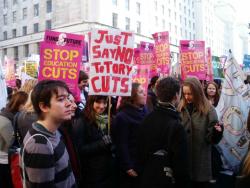 Since
Since
the financial crisis in 2008 many have watched what is being prepared
in society with a sort of stunned silence. People have grumbled that
there is no voice or movement for those who wish to fight the cuts. Yet
the atmosphere among the students was electric. It was as if, after a
period of feeling impotent and isolated, the students had found that
they were not alone, that they were part of a bigger movement with a
definite purpose.
A last minute surge of attendees from universities, along with the
presence of many school students from London who had boycotted school
for the day, pushed the numbers to over 50,000, according to estimates
given by the NUS. Such numbers were truly staggering, and were an
amazing sight to behold, with the vibrant student protest filling the
streets of central London for over five hours. The number of 50,000 was
all the more impressive considering that the protest was almost entirely
made up of students, with some university staff, and that it was the
middle of the week, thus requiring students to skip classes and not
allowing other workers to show solidarity. So buoyant was the mood of
the students that, as opposed to the typical stereotype of student
lethargy, the march spilled out of its starting position and left before
the scheduled time.
New layer of students politicised
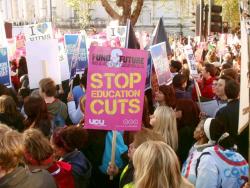 It
It
was clear that for the majority of the people on the demonstration,
this was their first experience of a large scale protest. This is an
extremely positive step for the student movement and for the class
struggle in general. A mass movement of workers and youth will be needed
to defeat the cuts, and a new generation of student activists is a
necessary step towards such a movement.
The large number of new student activists was also reflected by the
political slogans on display. In general, the majority of people were
angry about the rising fees. This was especially the case for the large
number of school students at the demonstration, who will be the first in
the firing line when it comes to the proposed £9,000 per year fees. The
majority of banners and chants were for “free education”, and not for
the official NUS position of a "graduate tax" (in which a progressive
tax is placed upon the income of graduates once in work). This shows
that the new layers that were getting involved are far ahead of the NUS
leadership.
There was an excellent turn-out from Scottish students, who are not
immediately affected by the measures being introduced by the Tories, but
clearly understand that they will not be able to escape the attacks
that are coming.
Despite the leadership of the NUS, with its support of a graduate tax
and with no clear strategy to defeat the cuts, the mood was excellent.
In particular the school students, many who said they were encouraged to
skip classes by their teachers, were grabbing bundles of Socialist
Appeal leaflets and handing them out. Flyers were literally being torn
out of the comrades’ hands. Again this shows the political nature of the
demonstration and the need for a leadership with a clear strategy to
fight the cuts.
History shows that the mood that develops among the student
population is a reliable barometer for the mood in wider society. This
was famously the case in France in May ’68, where it was first the
movement of the students that anticipated the magnificent movement of
the French workers, who later carried out the 10 million-strong general
strike which almost toppled capitalism in France.
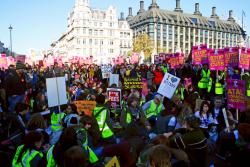 Sit-down protest in front of Parliament. Photo by Porstmouth Student Union.
Sit-down protest in front of Parliament. Photo by Porstmouth Student Union.
Recent
events in France have certainly been an inspiration for British workers
and youth, and there is no mistaking the fact that British society has
been influenced by the example of France.
This fact, in relation to the student demo, has been commented on by
much of the bourgeois media – that the NUS and the UCU carried out a
"French-style" demonstration. The Wall Street journal comments that
perhaps Prime Minister David Cameron should be asking Sarkozy to loan
them the notorious riot-busting CRS to tackle the students. When the
British students are accused of "acting French", what is being
acknowledged is that the students are becoming radicalised.
NUS leadership miscalculates
Before the day of the march Police estimates were for a turnout of
10,000. The estimate coming from the NUS was 30,000. Both clearly
misjudged the mood that had been building up among the student
population as over 50,000 students turned out.
This is an answer to those on the left who have tried on numerous
occasions in the past period to play the very irresponsible game of
demanding the creation of a “new, radical, democratic, fighting”
national union of students. Essentially they have tried to split the
NUS, claiming it only fit for beer tokens and clothing discounts. What
they have not understood is that the NUS is the traditional organisation
of the student movement in Britain. In the 1960s it moved radically to
the left under the pressure of events. The present leadership of the NUS
was shaped in a period of relative class peace, which was based on the
boom. It is only an imperfect reflection of the consciousness of the
movement below, which in turn is shaped by the hammer blow of events. In
the coming period the NUS will be pushed much further to the left as
the students try to shape it into an organisation that represents their
interests.
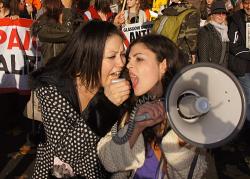 Students shouting slogans. Photo: Geoff Dexter.Today,
Students shouting slogans. Photo: Geoff Dexter.Today,
with over 80% of students having to work part-time to make ends meet,
the student body as a whole has become proletarianised and is very
definitely on the left. As the crisis has struck, this has been shown in
practice: faced with increasing anger amongst students, the NUS
leadership was forced, firstly, into organising a special “cuts
conference” in June 2009, and then to announce a national demonstration
jointly with the UCU.
Such announcements represented a qualitative
change in the student movement, which has been confined to small-scale
university occupations over issues such as Gaza in recent years.
As a traditional organisation of the students the reserves of support
that the NUS has at its disposal cannot be underestimated, as
Wednesday’s mobilisation reveals.
The NUS leadership has been dominated by reformist careerists in the
last decade. The last thing NUS president Aaron Porter wanted – who,
unlike his New Labour predecessors, has had the misfortune of being
“born in interesting times” – was this demonstration, which he was
forced to call under pressure from below. The choice of a weekday for
the demonstration was meant to keep the attendance low. The NUS
leadership hoped that the protest could be used to quietly allow
students to let off some steam, in much the same way as trade union
leaders in Europe have used one-day general strikes to allow some
pressure out of the labour movement. In reality the national
demonstration of students was a success despite the leadership,
and will only have served to raise the consciousness of the new layer of
youth that has entered onto the arena of the class struggle. What
shaped the mood was the widespread discontent which exists throughout
British society, and has been concentrated in the "excluded generation"
of under-25s who are fast realising what impact the cuts will have.
Millbank
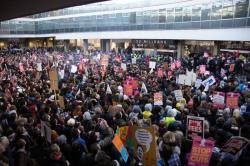 Students protesting outside Tory HQ. Photo: Geoff DexterAn
Students protesting outside Tory HQ. Photo: Geoff DexterAn
attempt has been made by the media to play down the real meaning of
this mass demonstration of students, by concentrating all their reports
on what happened at the Millbank Tower, which hosts the Conservative
Party headquarters. The windows of the building were smashed in, with a
few dozen student occupiers reaching the roof. This attracted a much
wider periphery of two or three thousand (or more), who stood outside
the building directing chants against the Tories for several hours,
until police reinforcements arrived to beat back the remaining
protestors and evacuate the building. Although the attack on the
Millbank Tower was clearly initiated by a minority of ultra-lefts, it
was evident that large numbers of students looked on with sympathy. One
student said: "this is what happens when those in power attack ordinary
people".
In and of itself this action has solved nothing and is not a method
that the labour movement would adopt. But one has to recognise that the
severity of the government’s attacks is provoking an extremely angry
mood among students and the responsibility for such a situation should
be placed where it belongs, on the shoulders of the Tories and the boss
class they represent.
In his response to the media, Porter, unfortunately preferred to use
his air-time to concentrate on condemning the occupiers of the Millbank
Tower, accusing an “unrepresentative minority” of “ruining it for
everyone” rather than directing his main fire at the Tories for the
violence they are visiting on the British working class. Such outbursts
of violence are nothing compared to what the Tories have in store for
working people and youth in this country.
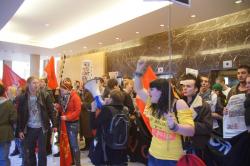 Students getting inside the Millbank building. Photo: Geoff DexterThe
Students getting inside the Millbank building. Photo: Geoff DexterThe
capitalist press have jumped on this question. It is in itself a
sensationalist news story that will sell a lot of papers. More
importantly it distracts from the real question, which is, in the first
place, "why are the students marching?" Cameron and fellow Tory, London
Mayor Boris Johnson, have been quick to condemn the students. One
student commented online that the they had gone from being portrayed as
"lazy hippies to hooded yobs", and that while it is merely "hi-jinks"
for the Bullingdon club (a notorious and exclusive Tory dining club at
Oxford university) to smash up restaurants, when Tory HQ is attacked
"things have gone too far". Cameron, who has been on a trade mission to
China, explained to the Chinese press that British students were
experiencing a tax-hike "so that foreign students can pay less (!)".
Had the anarchists gone tearing down Oxford St, smashing shop
windows, it would have been seen as the usual crowd of ultra-lefts
carrying out acts of vandalism. However, the Millbank incident will have
been seen in a different light by many. This is because this was the
headquarters of the party of the bankers and big business, the party
that is destroying the very basis of a civilised existence for millions
of workers.
Students have reported a sympathetic response from ordinary working
class people. An example of this was reported by students of Worcester
University, who on the way back from the demo stopped off at a service
station, where a little old lady serving behind the check-out, on
recognising the students from the news, reportedly remarked "…good on
you lads, somebody has to show those Tories we will not be walked over."
The role of the police at the Millbank occupation presents an
interesting question. Thatcher in the 1980s always took care to look
after the police, raising their wages whilst they attacked the miners
and printers. Today this is not the case and the police are suffering
the same cuts. A couple of years ago 25,000 police marched through the
streets of London in protest over their wages and conditions. This shows
us the depth of the capitalist crisis, where the bourgeoisie are eating
into their traditional reserves of support.
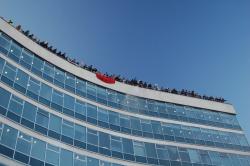 Occupiers on the roof of Tory HQ. Photo: SonniesEdgeHowever,
Occupiers on the roof of Tory HQ. Photo: SonniesEdgeHowever,
we have to distinguish ordinary police officers from Chiefs of Police.
In the bourgeois press the next day the message to the police was clear.
Under the guise of "sincere concerns" that the police had been cowed by
the previous years’ bad press at the G20, where a demonstrator – Ian
Tomlinson – died after police brutality, the question was raised: "are
the police too restricted in their actions?’ The message is clear. From
now on, we will see a much more aggressive stance on the part of the
police in the coming period. And that is not because of what happened at
Millbank. The bourgeoisie has launched a severe attack on workers and
there is no room for compromise.
The serious bourgeoisie will not be too concerned about a little
damage to private property, which they can easily afford to replace –
and which in any case comes in very useful as a propaganda tool to
justify their stepping up of police repression. What they are concerned
about is this militant mood of the students infecting the rest of the
working class. The government knows it has no concessions to offer –
therefore it will offer the baton instead. What was in their interests
was to let the occupiers have their way, to let rip and provide the
bourgeois press with some images to splash on the front pages. They wish
to demonise the students, and the idea of fighting the cuts. More
importantly they wish to prepare public opinion for the real battles
they foresee against an aroused working class in the future.
Having considered all the above, what would be dangerous is the idea
that "direct action" by students alone can stop the Tory attacks.
Effective direct action can only be carried out by the organised labour
movement, mobilised with a programme to nationalise the banks under the
democratic control of the working class – the only class that has the
power to take on the bankers and capitalists and their stooge Tory
government.
Where next for students?
For most of the 50,000 students at the national demonstration, the
question in the minds now will be “what next?” It is clear that
demonstrations alone will not defeat the cuts. The huge demonstrations
of over one million people in London in 2003 against the Iraq war failed
to stop the Blair government. The ruling class can tolerate
demonstrations, however strong, as long as these do not challenge their
right to govern over society. What is required is a movement that can
bring this government down.
The immediate task for students now is to build a fighting campaign
against the fees and cuts in every university, in association with
school students and university staff. Pressure must be put on student
union leaders on every campus to call for mass meetings of students,
along with the various unions representing staff – the UCU, Unite, and
Unison. These campaigns must be linked up with the local labour
movement, in order to build a mass movement of workers and youth against
the cuts. The great events of May 1968 in France have shown what is
possible when students and workers unite and fight.
Ultimately we must tell the truth to students and workers: the
reforms of the past – free education, universal healthcare, retirement
at 65 on a decent pension – are no longer possible under capitalism. A
radical transformation of society is needed.
The national demonstration of students was important because it was
the first step in linking up the student movement with the wider working
class. What was clear was that this changed mood has not dropped from
the sky. It is the first point of escape for the seething discontent
that has accumulated as a result of the cuts. This mood the Tories
cannot cut back, and is raging just beneath the surface.
Thousands of students went home to their respective universities with
a story to tell and a political education a hundred times more valuable
than what can be gained from a textbook or a seminar. Hundreds of
thousands of others looked on, and are beginning to draw their own
conclusions.
Remember the 10th of November. It marks an important beginning in
Britain. The movement of the students marks the first step in the class
struggle, a prelude to the awakening of the British working class.
Photo gallery
See also Geoff Dexter’s gallery:
